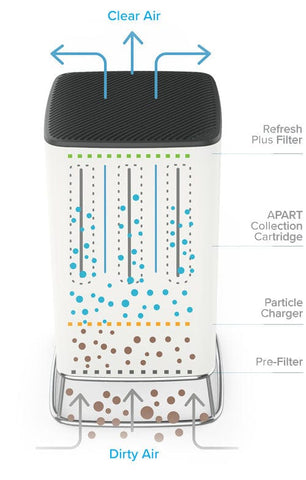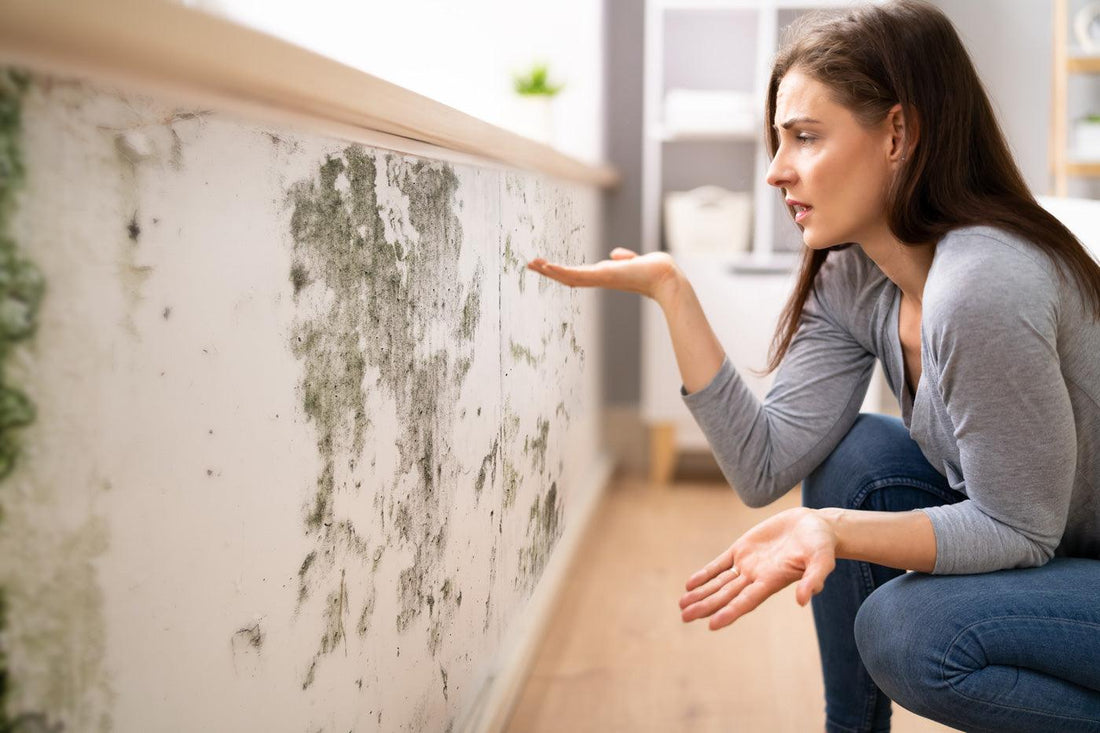Find out why a new electrostatic air purification technology may be the key to mold spore removal
But first, some background on why it matters:
Spring and summer are when mold growth is at its peak, as mold thrives in warm, humid conditions. Mold is a perennial problem which can cause discomfort and, in some cases, significant health issues. Heat events can increase the moisture content in the air, leading to more humidity and heavy rain events, making an ideal environment for mold growth.
What are mold allergies? What are the symptoms of a mold allergy?
Allergic reactions can occur with exposure to growing, spreading mold, mostly from airborne mold spores. According to the Mayo Clinic, “If you have a mold allergy, your immune system overreacts when you breathe in mold spores.” The symptoms of mold allergies can vary from person to person but include sneezing, headaches, runny nose, red eyes, and skin rashes. Depending on how severe the allergy and the length of exposure, symptoms can also include difficulty breathing and aggravated asthma.
How do I know if my home has mold? How does mold grow? Spread?
Although mold can sometimes be hidden, your eyes and your nose are usually the best mold detectives. Often you will see mold growing moist or humid areas, both indoors and out. And even if you can’t see it, you may smell mold. Mold can give off a musty, earthy damp smell, and this is often the first sign of a mold infestation. Molds are fungal organisms, found both indoors and outdoors, that grow by producing and spreading microscopic spores. The ideal environment for mold growth is high humidity or moisture. That’s why mold growth increases in summer months in humid regions. Mold spreads by releasing spores into the air that can travel long distances. If they land on a warm, moist environment, they can thrive and continue to spread. To grow, mold feeds on organic material, which is why you will see mold thriving on a rotting log. Mold grows less easily on inorganic materials, such as metal, concrete, or tile, but it still can grow if there is any organic material present on the surface.
So how do you prevent or reduce mold in your home?
It’s all about controlling the humidity. According to the Centers for Disease Control, humidity levels should be no higher than 50%, all day. How do you reduce humidity? Here are some suggestions from Forbes and others:
- Turn up the AC which will remove the warm air.
- Get a dehumidifier to moisture in the air
- Take cooler showers (cooler showers will reduce the amount of steam and moisture)
- Use the bathroom exhaust fan to remove moist air
- Fix leaky pipes and leaky roofs and scout around for any other leaks or places where moisture collects
- Get a humidity monitor and check it regularly
- Remove carpets or at least avoid installing them in naturally damp areas such as basements and bathrooms
- Use a highly effective in-room air purifier
- Carefully remove visible mold, wearing a mask and gloves
Do air purifiers help with mold?
Air purifiers are a great tool to use to stop mold from spreading. An air purifier that can remove fine and ultrafine particles and capture airborne mold spores which further prevents them from reproducing and spreading through the air. According to the CDC: “an air purifier will help capture mold spores that enter your home before they have a chance to land on surfaces where they can grow and cause problems. If you are currently dealing with a mold issue in your home, you should use an air purifier in conjunction with traditional surface treatments to prevent mold spores from spreading to other areas.”
Two types of air purifiers can remove mold spores, but there are important differences in the technologies, especially over time, between filter changes, as more mold is removed.
Clean Airflow is the Key to Removing Mold Spores Effectively: The Electrostatic Advantage
Here is a comparison of the long-term performance airflow between mechanical HEPA filters and non-clogging electrostatic air purifiers:
Electrostatic air purifiers are effective at removing mold spores from the air, as the static electricity allows them to capture even small, lightweight spores that could otherwise remain airborne
Why Brio® air purifiers are a great choice for mold

Mold spores can be quickly removed when Brio is in use. Brio quickly removes mold and other damaging airborne irritants as small as 0.0107 microns. Brio's patented, advanced technology does it without clogging a filter, so effectiveness stays high between filter changes, so you can be confident that you are always getting the same constant cleaning level, with no drop off.
HEPA air purifiers – which clog and have performance drop off - can’t make the same promise. And Brio's long-life, high-capacity filter cartridges make it a good value too, with fewer replacements – Brio’s particle collection cartridge lasts 3-4 times longer than similarly sized HEPA air purifiers. Brio is simple to operate, easy to maintain and is energy star rated. You can turn Brio on and leave it running 24 hours a day for about the same energy use as a 75-watt lightbulb. Find out more about Brio.
When to call a professional
According to the EPA, “Who should do the cleanup depends on a few factors. One consideration is the size of the mold problem. If the moldy area is less than about 10 square feet (less than roughly a 3 ft. by 3 ft. patch), in most cases, you can handle the job yourself.” If it is larger or more complex, it is recommended that you contact a mold remediation specialist. The EPA offers a great guide including tips and techniques for mold cleanup.
Mold growth can be a persistent problem in indoor spaces, leading to potential health issues and property damage. Mold can also have health effects, particularly when individuals are exposed to it for extended. Mold problems are worse in the summer and are exacerbated by extreme heat-driven rain events. The ideas presented her for reducing humidity will help reduce mold problems in your home, as will the use of an effective air purifier, like Brio, to stop the airborne spread of mold spores. By incorporating Brio air purifiers into your mold prevention strategy, you can create a cleaner, healthier living environment and minimize the risk of mold-related issues.
Looking for the best air purifier for mold?

